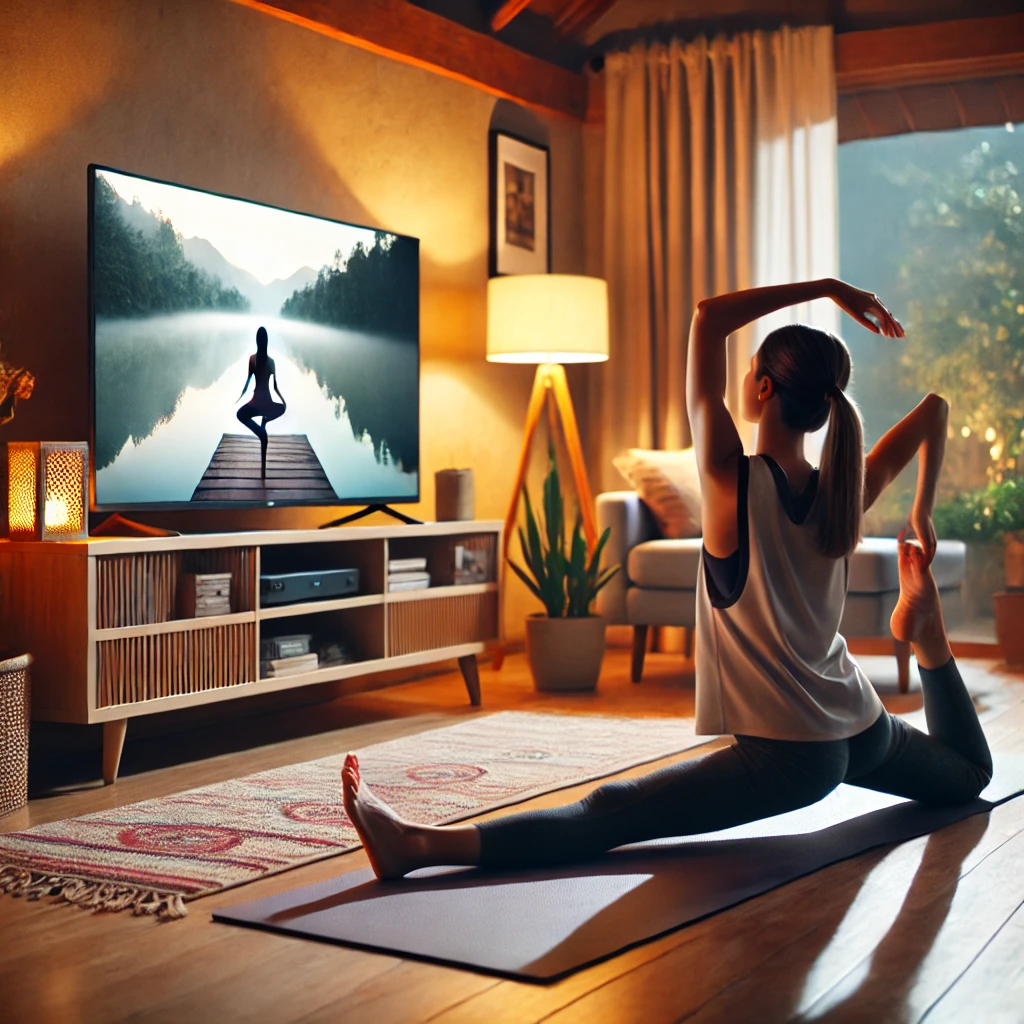In today’s fast-paced world, stress can accumulate without you even realizing it. This can lead to physical and mental fatigue, impacting your overall health and productivity. Fortunately, there are several stress-relieving techniques you can do while indulging in your favorite TV show.
These methods not only help you unwind but also promote overall well-being. By incorporating simple stress-relieving practices into your TV time, you can transform passive viewing into an opportunity for relaxation and rejuvenation. Here are some easy and effective stress-relieving techniques you can do during TV time.
Deep Breathing Exercises
Deep breathing exercises are a simple yet powerful way to combat stress. When you take slow, deep breaths, your body receives more oxygen, which helps to calm your nervous system. This stress-relieving techniques increases in oxygen levels, which leads to a host of benefits, including a reduction in anxiety and a feeling of relaxation throughout your body. Deep breathing activates the parasympathetic nervous system, which is responsible for the “rest and digest” response, effectively reducing your heart rate and blood pressure.
This technique can easily be done while watching TV. Simply focus on taking deep breaths through your nose, allowing your abdomen to expand as you inhale, and then letting the air out slowly through your mouth. You can place a hand on your belly to ensure you are breathing deeply and not just shallowly into your chest. As you practice this, try to clear your mind and concentrate on the rhythm of your breathing.
Not only does deep breathing help reduce stress, but it also improves focus and concentration. This can make it easier to enjoy and follow complex TV plots, enhancing your viewing experience. By integrating deep breathing exercises into your TV time, you are creating a dual benefit of entertainment and relaxation, helping you to unwind more effectively after a long day.
Progressive Muscle Relaxation

Progressive muscle relaxation (PMR) involves systematically tensing and then slowly relaxing different muscle groups in your body. This technique helps to reduce the muscle tension that often accompanies stress, allowing your body to relax more deeply. PMR is particularly effective because it brings awareness to areas of your body where you might be unconsciously holding tension, helping you to release it.
PMR can be conveniently performed from the comfort of your couch while watching TV. Begin by tensing the muscles in your feet, holding the tension for a few seconds, and then slowly releasing it. Move on to your calves, thighs, and so on, progressively working your way up through each muscle group until you reach your head. By the end of the exercise, you will have methodically relaxed your entire body.
This technique not only alleviates physical tension but also has significant mental health benefits. PMR can reduce anxiety, enhance your mood, and improve sleep quality, making it a valuable tool for overall well-being. Regular practice of PMR can lead to long-term benefits, such as a greater sense of control over stress and a more resilient response to everyday challenges.
By practicing PMR during your TV time, you can turn relaxation into a routine. This seamless integration of relaxation techniques into your everyday life helps to ensure that you consistently take time for self-care, even during leisure activities. Over time, you will likely find that you are better able to manage stress, feel more relaxed, and enjoy your TV shows even more.
Mindfulness Meditation
Mindfulness meditation focuses on staying present and fully engaging with the current moment. It involves paying attention to your thoughts, feelings, and sensations without judgment, which helps to cultivate a state of relaxed awareness. While mindfulness is often associated with quiet, solitary activities, it can also be practiced during more routine parts of your day, such as watching TV.
To practice mindfulness meditation while watching TV, start by fully concentrating on the show you are watching. Pay close attention to the storyline, the characters’ emotions, and the details of the scenes. Notice the colors, sounds, and movements on the screen. If your mind starts to wander, gently bring your focus back to the show. Observe any thoughts or feelings that arise, but try not to get caught up in them. Instead, acknowledge them and let them pass without judgment.
Studies have shown that mindfulness meditation can significantly lower stress levels, decrease symptoms of depression, and enhance emotional regulation. By practicing mindfulness, you train your mind to stay calm and centered, even in the face of stress or distraction. This can lead to greater emotional stability and an improved ability to handle life’s challenges.
Incorporating mindfulness meditation into your TV time not only enhances your viewing experience but also provides a convenient opportunity to practice mindfulness in a relaxed setting. Over time, this practice can become a natural part of your daily routine, helping you to remain present and engaged in other areas of your life as well. This dual benefit of entertainment and mental training makes mindfulness meditation a valuable addition to your stress-relief toolkit.
Stretching

Stretching is an excellent way to relieve tension and improve flexibility. It helps to loosen tight muscles, increase blood flow, and enhance overall physical health. By incorporating gentle stretches during TV time, you can effectively reduce muscle stiffness and improve your blood circulation, making your relaxation time more productive.
Stretching also releases endorphins, which are your body’s natural mood lifters. These chemicals help to reduce stress and promote a sense of well-being. The gentle physical activity involved in stretching can alleviate the physical and mental tension accumulated throughout the day.
Regular stretching offers numerous benefits, including improved posture, alleviation of back pain, and increased overall mobility. Maintaining good posture can prevent aches and pains, while increased mobility can enhance your ability to perform everyday tasks with ease. Stretching can be particularly beneficial for those who spend long hours sitting, as it helps to counteract the effects of prolonged inactivity.
You can perform simple stretches like neck rolls, shoulder shrugs, and leg stretches while seated or during commercial breaks. Neck rolls involve slowly rotating your head in a circular motion to relieve tension in your neck muscles. Shoulder shrugs can be done by lifting your shoulders up towards your ears and then releasing them back down. Leg stretches can be as simple as extending your legs out in front of you and gently reaching toward your toes.
By making stretching a part of your TV time, you transform a passive activity into an opportunity for physical well-being. This practice not only enhances your relaxation but also contributes to your overall health. Over time, you may find that regular stretching helps you feel more flexible, less stressed, and more comfortable in your body. So next time you settle in for a TV show, take a few moments to stretch and reap the benefits of this simple yet effective habit.
Visualization Techniques
Visualization techniques involve imagining a peaceful and calming scene or situation. This method can effectively reduce stress by shifting your focus away from stressful thoughts and toward more pleasant and relaxing imagery. While watching TV, try closing your eyes during less interesting parts of the show and visualizing a serene beach, a lush forest, or any place that feels relaxing.
Visualization has been shown to lower stress hormones, reduce anxiety, and improve mood. Combining this technique with your favorite TV show can create a powerful stress-relief routine that soothes both your mind and body.
Aromatherapy
Aromatherapy uses essential oils to promote relaxation and reduce stress. Scents like lavender, chamomile, and bergamot have calming effects and can be used during TV time for added relaxation. Diffusing these essential oils or using them in a room spray can enhance the atmosphere and create a more soothing environment.
Studies suggest that aromatherapy can reduce stress levels, improve mood, and even enhance cognitive function. By incorporating aromatherapy into TV time, a multi-sensory relaxation experience that maximizes entertainment and stress relief benefits can be created.
Integrating these stress-relieving techniques into TV time can transform a passive activity into a proactive way to manage stress. By making small adjustments and practicing these methods regularly, it’s possible to enhance overall well-being while enjoying your favorite show.
